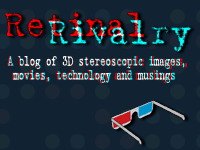For a while now I have been advocating the use of 3-D as a method for creating intimacy and emotion in storytelling, as a way to create a deeper personal connection for each individual audience member. And I’ve been arguing against the tendency in studio pictures to “dial-down” the depth during dialogue-heavy character driven scenes, as it’s so counter to how we experience real conversation and personal interaction. So I was thrilled to hear that director Wim Wenders is moving forward with his narrative feature “Every Thing Will Be Fine”. I thought that Wenders’ doc “Pina” was one of the best stereoscopic films I’ve ever seen, and a strong example of a movie that was made better by the intentional use of 3-D language (as opposed to the current compromise of 2-D language with 3-D applied as visual effect). The late Alain Derobe, originator of the “Natural Depth” method, was the stereographer on “Pina”, and I am thrilled to hear that Wenders will be working with his daughter Joséphine Derobe, also an accomplished stereographer and director, on the new picture. There was a discussion here recently about the necessity for directors and DPs to embrace the medium in order to move it forward as a storytelling tool, rather than as simply a gimmick used to sell tickets. Wenders was interviewed by James Franco in the latest issue of Playboy magazine, and had this to say:
WENDERS: I’m convinced 3-D can immerse audiences in the real world, even in intimate stories like this film. It brings audiences closer to actors, to how we deal with pain and life. We’re creating new realms of intimacy and presence with this technology. But the volume of the actors is more present in 3-D; their figure becomes a landscape in itself, so actors must find a new kind of acting. It’s untapped wealth. Many are looking for the secret formula. I’ll give it a shot, and eventually we’ll crack the code.
This gives me a little bit of hope for the future of 3-D in independent films.
A correction: In my previous post, I wrote about the Gadmei E8-3D autostereoscopic Android tablet, and erroneously stated that photos could be viewed directly from either a USB connected Panasonic Lumix 3D1 or FujiFilm Finepix W3 3-D camera. While this is possible with the Panasonic (and makes the tablet a great companion to that camera, which does not have a 3-D display of its own, the Fujifilm W3 does not have a “USB Mass Storage” mode, and will not show up as an external drive on the tablet. However, a USB card reader can be plugged into the tablet, and the W3’s memory card can be viewed using that method.

